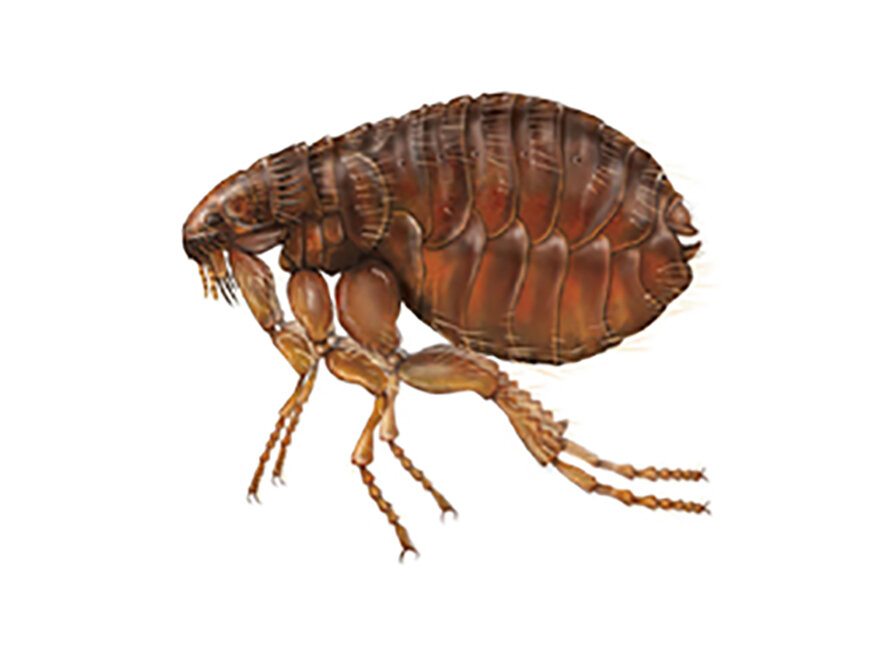How did my pet get fleas?
Fleas rarely jump from one pet to another, instead cats and dogs pick them up from infested environments. This could be your garden, the local park, a friend’s house – any place where an animal that has fleas, such as a hedgehog, possum or another cat or dog, may be found. Infested animals leave flea eggs behind wherever they go. New fleas hatch from these infested environments once they sense the warmth, the carbon dioxide and vibrations an animal such as your pet creates and jump onto them.
Flea treatment is an all-year-round commitment because fleas can be active in all seasons. Treatment is based on the weight of your pet and is different for cats and dogs. Although you may be vigilant with your treatment plan, infestation may simply occur by an untreated passing animal, and the flea eggs falling off their coat into your pets environment, indoor or out!
The flea life cycle is complex:
Stage 1 - Flea Eggs:
Up to 50 white small flea eggs per day may be laid by an adult female flea on your pet. These flea eggs fall off the pet’s coat into the environment with eight hours of being laid.
Stage 2 - Flea Larvae:
Flea eggs hatch within on to 10 days into larvae. Flea larvae are mobile, they will move away from light, towards moisture and the ground.
Stage 3 - Flea Pupae:
With five to 11 days, flea larvae spin a sticky silk cocoon to become pupae which can remain dormant for up to six months, depending on the environment and conditions. (It is important to note that no insecticidal treatment kills pupae so it is important to remain vigilant with your prevention plan.)
Stage 4 - Adult Fleas:
Young fleas are stimulated to emerge from the cocoon by your pet’s body temperature, movement, shadows and exhaled carbon dioxide. Within a second, your passing pet may acquire newly emerged fleas from its home environment and with adult fleas mating on your pet within 8-24 hours, the production of flea eggs and the cycle begins again at stage one with 24-48 hours.
Development from flea egg to an adult flea can vary from as little as 12 days to as long as 325 days.
THE PROBLEMS FLEAS CAUSE
Fleas are blood-sucking parasites that can make life miserable for pets and their owners.
They can cause:
Intense itching and scratching which can result in hair loss
Flea Allergy Dermatitis – a very common and unpleasant skin condition caused by an allergy to flea saliva
Tapeworm infestation
Anaemia in puppies and kittens.
HOW TO PREVENT FLEAS
Use treatment regularly as directed by the instructions on the product you have purchased, to kill adult fleas on your pet.
Make sure all cats and dogs are treated. Each pet in your household can act as a host for a flea infestation.
Regularly vacuum your carpets and furnishings and wash your pets bedding above 60°C. This will help to reduce the number of any eggs, larvae and pupae in the environment.
Note it is normal to see a few new fleas on your pet even after treatment as treatment does not repel fleas, so if the pet visits an infested environment, a few new adult fleas may jump onto them. These new fleas will be killed within 24 hours or so, depending on the treatment product you have chosen.
HOW TO TREAT A FLEA INFESTATION
Allow treated pets continued access to infested areas as fleas that hatch from pupae in the home can then jump onto your pet and be killed through contact with your treatment. No insecticidal treatment kills pupae so this is an important step.
Use treatment regularly as directed by the instructions on the product you have purchased, to kill adult fleas on your pet.
Make sure all cats and dogs are treated. Each pet in your household can act as a host for a flea infestation.
Regularly vacuum your carpets and furnishings and wash your pets bedding above 60°C. This will help to reduce the number of any eggs, larvae and pupae in the environment.
Use an environmental spray or fogger containing an Insect Growth Regulator. This will kill eggs and larvae that are developing in the home environment. Existing pupae will continue to hatch for several weeks until the population is depleted.
RECOMMENDATIONS
to help reduce the risk of flea re-emergence and re-infestation:
Discard all flea infested items, eg bedding where practical.
Clean between floor boards and in cracks between tiles and pavers.
Vacuum regularly; steam clean where possible. This will assist with removal of eggs and stimulate fleas to emerge.
Wash pet bedding and blankets regularly in hot water.
Place items that come into contact with pets but cannot be washed in direct sunlight every few days (ie cushions, door mats, rugs etc) this will help kill the immature flea stages.
Prevent pet’s access to areas of potential flea contamination. For example in moist shady areas, under the house or veranda.
If possible prevent other pets from visiting you home that have not been treated.
Conduct a “white sock test”. Put on a pair of long white socks and walk around your pet’s environment. This will stimulate any fleas to emerge and jump onto the socks, this will help you determine if you have a flea problem, and where they are coming from. This way if you find the source you can concentrate cleaning efforts here.





